Xeriscape Landscape Plants & Flowers
For The Arizona Desert Environment.
Pictures, Photos, Images, Descriptions, & Reviews.
Century Plant, Agave americana.
We Are Proud Of Our SafeSurf Rating!
Click On Any Of The Following Links By Amazon.Com
For Books, & Videos About Wildflowers Of Arizona & The Southwest USA. No Obligation!
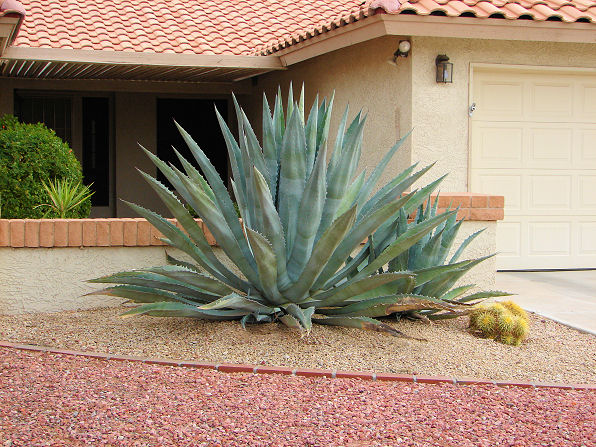 |
| Century Plant, Agave americana. Westbrook Village, Peoria, Arizona. March 16, 2006. |
|---|
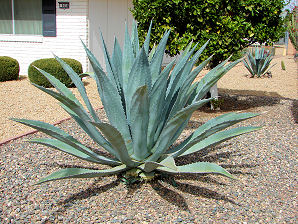 | 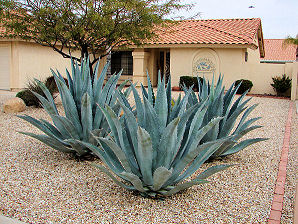 |
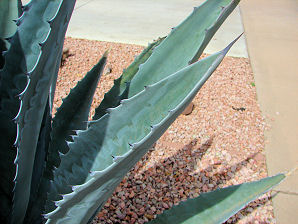 | 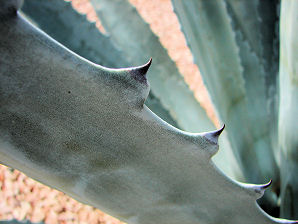 |
| Century Plant Leaves | Century Plant Spines |
 /
/

Century Plant.
We wish to thank Wikipedia, the free encyclopedia for some of the information on this page. We share images and information with Wikipedia. Agave americana, commonly known as the century plant, maguey, or American aloe (although it is in a different family from the Aloe), is an agave originally from Mexico but cultivated worldwide as an ornamental plant. It has since naturalised in many regions of the world and it now grows wild in Europe, South Africa, India, and Australia. A thick-leafed evergreen succulent which dies after blooming. It has pointed leaves which form a basal rosette. It has a slow growth rate. It becomes very large. Century Plant becomes a large agave over 7 feet tall. It spreads to about 8 to 12 feet. It has long gray glaucus leaves that have recurved spines on the margins and a long terminal spine. It's yellow-green flowers attract hummingbirds, however the Century Plant doesn't bloom until it is about 10 years or so old. It does not take 100 years to bloom! The flowering plant dies shortly after flowering. Plant in full sun. Irrigate occasionally. Not too often! This is a large plant but care must be exercised when choosing to plant; give it plenty of room and keep it away from traffic. The spines are dangerous. Some people think Agave americana is the Agave grown for tequila. Technically, tequila is a type of mezcal, however all mezcals are not tequila. To be a true tequila, it must be derived from Agave tequilana Weber azul, or more commonly known as the Webers Blue variety of Agave tequilana.The tequila also must be produced in the Mexican state of Jalisco. Mexican laws state that tequila can be produced only in the state of Jalisco and limited regions in the states of Guanajuato, Michoac�n, Nayarit, and Tamaulipas. Mexico has claimed the exclusive international right to the word "tequila", threatening legal actions against manufacturers of distilled blue agave spirits in other countries. We have been to the state of Jalisco and the town of Tequila and you can smell the Agave fermenting for several miles away. You can also see the harvested Agave tequilana Weber azul plants stacked along the roadway or in the fields, waiting to be moved to the fermenting and distilling plants in the region. Mezcal is made from one of 5 or 6 species of Agave. Agave americana, is one used for mescal, not tequila. It was given the name Century Plant, since it is said to take a century to bloom. NOT TRUE! Century plant doesn't really take a century to bloom, but it does take 10 years or so in warm regions, such as in Arizona, and as much as 60 years in colder climates. Like many other Aguave, It dies after blooming (a condition called monocarpic), but it produces offsets or "pups" throughout its lifetime and these fall off or can removed to be replanted to continue the lineage. The sap of century plant is used as a diuretic and a laxative. The juice of the leaves is applied to bruises and taken internally for indigestion, flatulence, constipation, jaundice and dysentery. Steroid hormone precursors are obtained from the leaves. The flower stalk and heart of century plant are sweet and can be roasted and eaten. The native peoples of the USA & Mexico have been doing this for hundreds of years. The seeds are ground into flour to make bread and to use as a thickener for soups. Pulque is a beer-like drink made from the fermented sap of century plant or (more commonly) the closely-related Agave salmiana.
Quick Notes:
Height: 5 to 7 feet tall. It spreads to about 8 to 12 feet.
Flowers: A large stalk emerges from the center of the plant, it becomes 15 to 30 feet tall. Then yellow flowers emerge from the terminal end on a horizontal branching structure growing up to 6 feet in diameter. The flowers are pale yellow, up to 3 5/8 inches long, with perianth segments erect, up to 1 1/4 inch long, the ovary is shorter than the perianth.
Flowering Time: Phoenix Arizona, Mid March - April.
Leaves: The leaves symmetrical, a basal rosette, up to 6 feet long, nearly 12 inches wide, gray, curved or reflexed at the tip, margin toothed.
Found: Native of many states (very wide range) (exact location of origin unknown) in Mexico. The USDA claims it is now native to the USA (AZ, CA, FL, HI, LA, TX), USA+ (VI).
Hardiness: It will freeze past the low 20 �F ! *However some sources say it will survive down to 15 �F.
Soil pH requirements:
Sun Exposure:
Elevation: Said to grow from 0 - 7,600 Feet. In Arizona. We doubt that! It can't take the cold at that elevation.
Habitat: It grows well in sand, sandy loam, clay and other heavy soils. It needs good drainage and aeration. It is remarkably tolerant of alkali.
Miscellaneous: Maintenance: Low. Photos Taken; Westbrook Village, Peoria, Arizona. March 16, 2006.
|



We Are Proud Of Our SafeSurf Rating!
Click On Any Of The Following Links By Amazon.Com
For Books, & Videos About Xerioscape Plants Of Arizona & The Southwest USA. No Obligation!
Back To Arizona Xeriscape Landscaping Main Page.
Back To Xeriscape Succulents Page Two.
Back To Arizona Wild Flowers Home Page.
Back To DeLange Home Page
© 1966 - Present, Audrey, Eve, & George DeLange
| © 1966 - Present, Audrey, Eve, & George DeLange |


